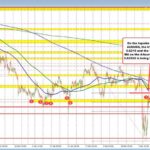
AUD/USD Forecast: Navigating Market Volatility and Economic Challenges
Tháng 4 10, 2025Escalating Trade War: The Impact of 145% Tariffs on U.S.-China Relations
Tháng 4 10, 2025Analyzing March 2025 Inflation Trends: Insights from Ireland and the U.S.
As we navigate through 2025, recent inflation data showcases significant trends that affect economies across the globe. The most recent statistics reveal a notable surge in consumer prices, specifically in Ireland, while the United States showcases a nuanced shift in its core inflation rates. Understanding these trends is crucial for consumers, businesses, and policymakers alike.
Ireland’s Consumer Price Index: A Closer Look
In Ireland, the Consumer Price Index (CPI) recorded a rise of 2.0% from March 2024 to March 2025, marking a pivotal moment since this rate had not hit the 2.0% threshold since July 2024. This increase is indicative of underlying economic pressures that are beginning to exert influence over household budgets.
The main drivers of this uptick in prices can be attributed to significant rises in Alcoholic Beverages & Tobacco, which surged by 4.2%, and Food & Non-Alcoholic Beverages, which saw an increase of 3.3%. Such figures not only affect consumer spending but also indicate broader fluctuations in demand and supply chains within these sectors. It is essential for consumers to remain aware of these trends as they can lead to a shift in purchasing behavior and overall lifestyle adjustments.
U.S. Core Inflation: A Modest Easing
Turning to the United States, the annual core consumer price inflation rate demonstrated a slight easing to 3.1% in March 2025, down from 3.3% in January. This indicates a modest relief for American consumers who have been grappling with rising prices in previous months. The monthly increase in consumer prices held at 0.2%, contrasting with earlier predictions that anticipated a slight rise.
Further investigation into the specifics reveals that consumer durables and personal goods fueled this growth with a 0.2% increase, driven largely by demand for home appliances and recreational goods. This stability in pricing, relative to previous months, provides consumers a glimmer of hope for more predictable spending habits in the near future.
For those seeking to avoid mistakes in their investment strategies amidst fluctuating economic conditions, learning from key investment mistakes to avoid in 2023 can be crucial. Recognizing these pitfalls may enhance one’s ability to navigate financial uncertainties, further influenced by economic trends like inflation.
Employment Trends: Stability Amidst Inflation
Accompanying these inflation statistics are promising employment trends in the United States. Industries such as health care, social assistance, retail trade, and transportation and warehousing reported job growth during March. Notably, the unemployment rate held steady at 4.2%, suggesting a resilient labor market despite inflationary pressures.
The interconnection between employment trends and inflation cannot be overlooked. As people have more job security and disposable income, demand for goods could maintain consumer prices at a more stable level, countering potential inflationary spikes.
Conclusion: What Lies Ahead?
For both Ireland and the United States, the trends set forth in March 2025 provide insights into the current economic climate. The rise in Ireland’s CPI sends a clear message about expanding costs that could impact local spending habits, while the stabilization of core inflation in the U.S. can offer some respite for consumers. As these economies continue to evolve, it remains crucial for stakeholders and decision-makers to monitor these changes closely, adapting to the shifting landscape of inflation, employment, and consumer behavior.
For investors pondering the effectiveness of various strategies, exploring the three reasons why value investing beats the market might also offer valuable insights. Understanding these inflation trends will be paramount in navigating future economic decisions, ensuring that both consumers and businesses can thrive in an ever-changing environment.

